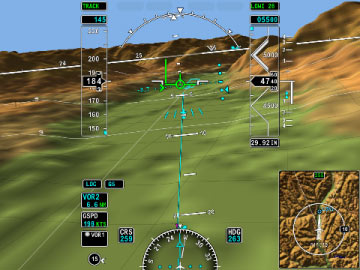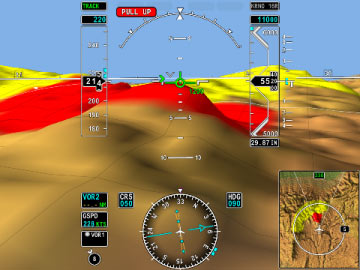Manufacturing giant Honeywell has developed a new safety system to show the pilot where the plane is in the sky when visibility is low and, more importantly, whether it's about to crash into anything. Silicon.com recently got to see the new system in action on a test flight in a private plane.
 The black screen on the right shows the Remote Access Aviation System (RAAS) pilots currently use to fly in low-visibility conditions. It provides a 2D representation of the area surrounding the plane and, using a terrain database, alerts the pilot if the plane is too close to the ground or any obstacles. On the left is Honeywell's new 3D system, the Synthetic Vision System (SVS).
The black screen on the right shows the Remote Access Aviation System (RAAS) pilots currently use to fly in low-visibility conditions. It provides a 2D representation of the area surrounding the plane and, using a terrain database, alerts the pilot if the plane is too close to the ground or any obstacles. On the left is Honeywell's new 3D system, the Synthetic Vision System (SVS).
 If the plane gets too close to the ground, or an obstacle appears, the landscape turns red, signaling imminent danger. This is akin to RAAS, which uses red and an audio alert sound to signal danger. You can see a color representation of the old system in the lower right-hand corner of the image here. SVS is not designed to replace the existing 2D system but to assist pilots when flying in zero-visibility conditions.
If the plane gets too close to the ground, or an obstacle appears, the landscape turns red, signaling imminent danger. This is akin to RAAS, which uses red and an audio alert sound to signal danger. You can see a color representation of the old system in the lower right-hand corner of the image here. SVS is not designed to replace the existing 2D system but to assist pilots when flying in zero-visibility conditions. The runway was clearly visible as the plane touched down--the SVS is shown here running on a PC for our trial flight, though ultimately it will be integrated into the plane's computer systems. After initial skepticism, pilots who have tested the SVS are embracing the new technology and questioning how they ever survived without it, a Honeywell engineer said.
The runway was clearly visible as the plane touched down--the SVS is shown here running on a PC for our trial flight, though ultimately it will be integrated into the plane's computer systems. After initial skepticism, pilots who have tested the SVS are embracing the new technology and questioning how they ever survived without it, a Honeywell engineer said.Gulfstream is the first airline to adopt SVS, and the product will be installed on its newest G450 aircraft in 2007. Upcoming features include the ability to display other nearby aircraft on the screen to prevent midair collisions--but that will have to wait on a mandate from the aviation industry to install GPS on every plane.
No comments:
Post a Comment